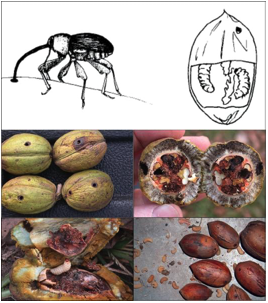From the Vine: Controlling Pecan Weevils
go.ncsu.edu/readext?1082524
en Español / em Português
El inglés es el idioma de control de esta página. En la medida en que haya algún conflicto entre la traducción al inglés y la traducción, el inglés prevalece.
Al hacer clic en el enlace de traducción se activa un servicio de traducción gratuito para convertir la página al español. Al igual que con cualquier traducción por Internet, la conversión no es sensible al contexto y puede que no traduzca el texto en su significado original. NC State Extension no garantiza la exactitud del texto traducido. Por favor, tenga en cuenta que algunas aplicaciones y/o servicios pueden no funcionar como se espera cuando se traducen.
Português
Inglês é o idioma de controle desta página. Na medida que haja algum conflito entre o texto original em Inglês e a tradução, o Inglês prevalece.
Ao clicar no link de tradução, um serviço gratuito de tradução será ativado para converter a página para o Português. Como em qualquer tradução pela internet, a conversão não é sensivel ao contexto e pode não ocorrer a tradução para o significado orginal. O serviço de Extensão da Carolina do Norte (NC State Extension) não garante a exatidão do texto traduzido. Por favor, observe que algumas funções ou serviços podem não funcionar como esperado após a tradução.
English
English is the controlling language of this page. To the extent there is any conflict between the English text and the translation, English controls.
Clicking on the translation link activates a free translation service to convert the page to Spanish. As with any Internet translation, the conversion is not context-sensitive and may not translate the text to its original meaning. NC State Extension does not guarantee the accuracy of the translated text. Please note that some applications and/or services may not function as expected when translated.
Collapse ▲Controlling Pecan Weevils in North Carolina: What Homeowners and Growers Need to Know
Pecan trees are a valuable part of many home landscapes and small farms in North Carolina, but one late-season pest can quickly ruin a year’s crop—the pecan weevil. This insect causes significant damage by puncturing pecans in their soft-shell stage to feed and lay eggs. The developing larvae feed on the kernels inside the shell, hollowing out the nuts and leaving exit holes as they emerge. Infested nuts often fall prematurely or are left with little to no edible meat. Understanding how to monitor and manage pecan weevils is critical for protecting your crop, especially during August when the pest is most active.
Adult pecan weevils typically begin emerging from the soil during the first couple of weeks in August, especially after a soaking rain. This makes early August the key time to start scouting. One of the most effective and low-cost tools for monitoring adult activity is a sticky barrier called Tree Tanglefoot. Applied in a band around the trunk about five to six feet above the ground, this product captures adult weevils as they crawl up from the soil to reach the canopy. Burlap traps tied around the trunk can also be used to catch the insects during their climb. These traps should be checked daily, and any captured weevils should be destroyed. Scouting should begin in early August and continue into mid-September.
Cultural practices play a major role in managing pecan weevils, especially when combined with chemical controls. Good sanitation is essential—pick up fallen nuts daily and destroy any that show signs of weevil entry or larval damage. This prevents larvae from entering the soil, where they can pupate and re-emerge in future years. Because the weevil’s life cycle can span one to three years underground, allowing infested nuts to remain on the ground only fuels future outbreaks.
Maintaining a clean orchard floor and mowing the area beneath the canopy can also reduce habitat for adult weevils. Proper pruning helps improve airflow and sunlight penetration, which supports overall tree health and makes it easier to apply treatments. Selecting pecan varieties that are disease-resistant, particularly to pecan scab, will help reduce stress on trees and support pest management efforts.
Chemical control should be used when adult weevils are first detected. The most effective insecticide for homeowners and small orchardists is carbaryl, sold under brand names like Sevin or as generic formulations such as Carbaryl 4F. A liquid spray should be applied as a trunk and lower-canopy spray when adult weevils are first observed, usually in mid-August. Applications should be repeated every 7 to 10 days until mid-September, or as long as weevils continue to be trapped. Be sure to follow all label instructions for rates, personal protective equipment, and re-entry intervals.
Bifenthrin-based sprays are also an option, particularly for trunk treatments. These provide about a week of protection per application and can serve as a supplement to carbaryl sprays. Regardless of which chemical is used, insecticides work best when paired with cultural methods like Tanglefoot bands and nut sanitation. Keep in mind that dust formulations are generally not as effective as liquid sprays, especially when trying to get good coverage on large trees.
Once mid-September arrives and adult activity begins to taper off, Tanglefoot bands should be removed to prevent bark damage or girdling. Continue to collect dropped nuts and evaluate overall weevil pressure. Because some weevils may remain in the soil and emerge over the next one to two years, consistent management from season to season is essential to reducing populations long-term.
In summary, controlling pecan weevils in North Carolina requires a combination of timely scouting, cultural practices, and appropriate chemical use. Start monitoring in early August using Tanglefoot or burlap traps. Remove and destroy infested nuts, keep the base of the tree clean, and apply carbaryl sprays when adult weevils are present. Repeat treatments as needed through mid-September. With persistence and proper timing, you can protect your pecan harvest and enjoy a healthier crop for years to come.




